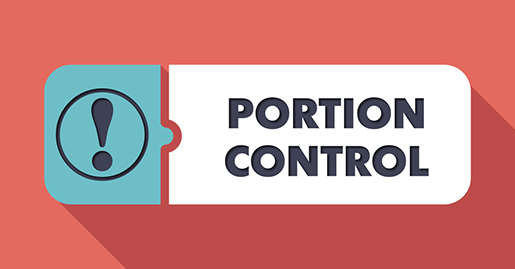 Often, we consider a portion to be whatever seems reasonable to us personally, or whatever is arbitrarily placed in a package.
Often, we consider a portion to be whatever seems reasonable to us personally, or whatever is arbitrarily placed in a package.
We tend to define moderation as what we perceive to be an occasional treat or indulgence.
But how conducive are those self-created concepts to weight loss and weight maintenance?
Although the majority of Americans tend to answer on surveys that they practice portion control and eat in moderation, 2 in 3 Americans are overweight or obese. There seems to be a disconnect between portion control, moderation, and what it is we’re truly practicing in our daily lives.
We must consider what portion control truly is, and what moderation truly is in order to practice these “eating arts” appropriately; in doing so, we may create a path towards a healthy body weight and healthy relationship with food.
In a manner conducive to the maintenance of a healthy body weight, “portion control” refers to the serving of foods and beverages in portions appropriate to one’s individual caloric needs. An average chicken breast may range anywhere from 4 to 12 oz, with calories inflating with each additional oz. You can’t just cook one and assume that it’s a reasonable portion. We tend to assume that the calories in healthy foods don’t matter, but they do. When you are trying to fuel your workouts, create a calorie deficit and lose weight, calories matter and what your calories are made of (carbs, fats, protein) matters too.
To serve yourself a proper portion, you must consider how many calories you need, and how many calories you’ve already consumed (or plan to consume) throughout the day. This is why loose structure helps: you don’t need to plan for every single calorie, but having a simple meal structure/plan can help you look into the future and serve yourself appropriately in the moment.
Portion control can be a shocking exercise at first: it is mind-boggling how many calories our typical servings and favorite foods can contain, so be patient. Understand that, at first, your body may feel less satisfied with smaller portions, but in time, your body will adapt to feel full on less.
The best method to practice in terms of overall health and weight maintenance is a volumetric-style eating approach: fill your plate with low-Calorie vegetables (prepared without oil, dressing, or additional fats) to round out your meal and aid in your sense of satiety. Come up with a split that works for you, for example 30% carb, 30% fat and 40% protein. I also suggest that you buy a food scale and take some time weighing out portions so that you get familiar with what 400 calories of chicken looks like or 100 calories of carrots.
Moderation, a lovely concept, is yet another “eating art” that tends to go astray, with the influx of calories ultimately preventing our losses on the scale.
Moderation implies that we eat a healthy diet and consume “junk food” or “treats” in moderation.
However, many of us practice a so-so, somewhat committed diet and then splurge on even more high-calorie extras in what we believe to be the practice of moderation.
True moderation implies that we consume a mix of foods that are both healthy for (vegetables, dairy, fruit, lean meats, whole grains, healthy fats) and unhealthy for (candy, desserts, junk foods) our bodies, but always in a way that is calorically appropriate. That means that we make the extra, unhealthy food fit into our calorie and nutrient goals. In this manner, we are able to healthfully incorporate those less healthy foods without totally jeopardizing our physical (and often mental health) through detrimental numbers on the scale because of balance.
However, it’s important to understand that our eating habits aren’t just about weight loss, but also health. We have to really consider how unhealthy food is affecting our overall health. There is nothing wrong with cutting a lot of it out in an effort to achieve greater wellness.
Although it can be tempting to over-eat and over consume calories in a blur of what we consider to be fun, social eating and “moderation”, remember that these patterns are ultimately ones that may leach into our health, not just physically, but also emotionally. For those who suffer from self control issues around food and stress eating, moderation and portion control is a big problem. Binge eating disorders and emotive eating are more prevalent than ever, so it’s important to consider how our food habits and perceptions impact both our physical and mental health.
Moderation and Portion Control: A Beginner’s Guide
- Make a two-column list of foods: one column with foods that will aid your body, and one column with those foods that aid your eating experience: do you need more broccoli, but desire chocolate peanut butter cups? Then both make the list, albeit in separate columns. You now have, at a glance, your personal eater’s guide.
- Now, write the number of Calories you need to reach and maintain your goal weight at the top of those columns. (Need help coming up with that number? Check out the calculators at freedieting.com and myfitnesspal.com)
- Now it’s time for number crunching: research the Calories of various foods and their serving sizes. Aim for no more than 300-500 Calories of foods from the “treat”/unhealthy indulgences column each day.
- Create a list of the foods you plan to eat most often. Try a 10/10/10 approach with 10 breakfast ideas, 10 lunch ideas and 10 dinner ideas. Use these to create a 14-30 day meal plan. Write it all out and add in snacks and cheat meals. Focus on your daily calorie and nutrient goals. By doing this you will see that healthy, balanced eating is possible for you.
- Don’t worry about always counting the calories in non-starchy vegetables (think green veggies like greens, broccoli, lettuce, etc), but calories from starchy veggies (yams, sweet potatoes, russet potatoes, corn, peas) do need to be counted for their higher Caloric content. Non-starchy veggies will be your plate-fillers: they are the foods that will promote health and weight maintenance, filling you up without packing on pounds. Ultimately, these food help you maintain- at last- balance!

Comment Via Facebook